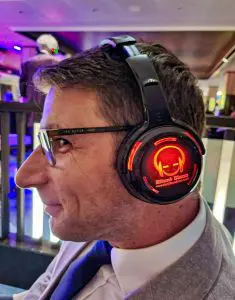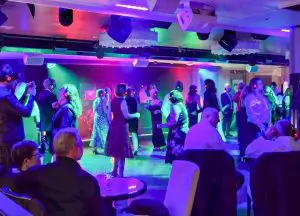 If you’re anything like us then you’ll love a good boogie, it provides such a joyful experience and allows people to escape from the stresses of their everyday life. Dance is a wonderful form of expression and social connection, so we were intrigued when we heard about silent discos because the term seemed to be a huge contradiction.
If you’re anything like us then you’ll love a good boogie, it provides such a joyful experience and allows people to escape from the stresses of their everyday life. Dance is a wonderful form of expression and social connection, so we were intrigued when we heard about silent discos because the term seemed to be a huge contradiction.
Having been eager to attend a silent disco for a while, we had the opportunity to try one during a cruise on the P&O Britannia in May 2023. Although we had a general premise of how they worked we were still intrigued as to what was involved if you actually attended one. So, we’re here to lift the veil and tell you everything you need to know about what a silent disco is and a little insight into why they are so popular.
Ad Disclaimer!
This website uses paid adverts and affiliate links, these come at no additional cost to you and help us to fund the operation of the website, meaning we can continue to provide you with valuable content.
The money received from these links and adverts do not influence any recommondations made within our content.
Page Contents
How Do Silent Discos Work?
Although commonly known as a silent disco, we have also seen them advertised as a silent party or silent headphone party. But it is basically an event where music is broadcast through noise cancelling wireless LED headphones, instead of the usual method of using sound systems and speakers.
 When you arrive at your silent disco you’ll be given a pair of the headphones. Transmitted to everyone’s headphones are the same two channels of music (although at some parties you may be lucky to have three). You can flick between each channel throughout the event and decide which you want to listen to, based on the music options available. As you alternate between the channels then the LED section of the headphones will change colour as an indication of which one you have chosen. The colours tend to be red, green, or blue, and they will show you who else in the room is listening to the same song as you.
When you arrive at your silent disco you’ll be given a pair of the headphones. Transmitted to everyone’s headphones are the same two channels of music (although at some parties you may be lucky to have three). You can flick between each channel throughout the event and decide which you want to listen to, based on the music options available. As you alternate between the channels then the LED section of the headphones will change colour as an indication of which one you have chosen. The colours tend to be red, green, or blue, and they will show you who else in the room is listening to the same song as you.
Interestingly when silent discos began, they only had one channel, but thankfully the technology has evolved to offer more because we feel it adds to the fun.
For each channel you will have a DJ who is vying for listeners, so they are aiming to play the best tunes to switch the dancers over to their song choice. You’ll even randomly hear whoops from people on a certain channel, due to one of the duelling DJ’s whipping his listeners into a frenzy. If the DJs are both decent then you’ll find that most people will jump between both channels. You’ll even find that friends in the same group will listen to different channels because of their own preferences.
One of the best parts of a silent disco is witnessing the party goers when you’re not wearing a set of headphones. Firstly, you can’t hear the music so the room is quiet which is quite nice on a night out with friends, it means you can have a chat as well if you want. Secondly, it’s the oddest event to witness, because you’re watching a room of people dancing and even singing along and there’s no music in the room.
As well as the headphones LED lights indicating what channel people are listening to, you’ll also have the fun of hearing people singing out loud; sometimes very loudly. Because the headphones are noise cancelling, it’s extremely easy to forget that you’re in a silent room where others maybe sat taking a break from the music. This leads to a hilarious mixture of songs being sung from the different channels.
The History of Silent Discos
 Looking into the history of Silent Discos, there is a reference in the 1967 Astroboy story ‘The Summer of 1993’, where everyone at a party wears headphones.
Looking into the history of Silent Discos, there is a reference in the 1967 Astroboy story ‘The Summer of 1993’, where everyone at a party wears headphones.
But the start of this type of partying was in the early 90’s by eco-activists, who used headphones at outdoor parties to minimise noise pollution and disturbance to the wildlife.
It was during the 00’s that this type of disco took hold, with a BBC Live Music ‘silent gig’ being held in May 2000 and in May 2002 artist Med Duguid held a silent party at the Museum of Contemporary Art Chicago. She threw a second party the following year entitled ‘Dueling DJs’ which was more akin to the silent discos we see today.
Bonnaroo Music Festival used the term silent disco in 2005 with an event featuring DJ’s Motion Potion, Quickie Mart, and DJ media4. But it was from around 2011 that silent disco companies began to pop up offering the equipment needed for parties, and the term was added to the Oxford Dictionary online.
Now you will find silent discos organised all over the country, with many taking place in cathedrals and historic buildings around the UK and Europe. In 2024 a sold-out silent disco held at Canterbury Cathedral was condemned because people felt it belittled the sanctity of the religious building.
In the earlier days of silent discos, more so before 2005, most only transmitted to a single channel. It was after 2005 that second and third channels were introduced which allowed the ability to transmit different music, which really adds to the enjoyment.
Pros and Cons of Silent Disco’s
 Silent discos are becoming increasingly popular, especially at music festivals. But are they worth it, and should you go to one instead of the usual musical gatherings. Here is our pros and cons list to help you decide.
Silent discos are becoming increasingly popular, especially at music festivals. But are they worth it, and should you go to one instead of the usual musical gatherings. Here is our pros and cons list to help you decide.
Pros
- They are tons of fun,
- You have more than one option of song to listen to,
- You have control over the volume of the music you’re listening to,
- If you want to talk to friends then you can, simply remove the headphones and the best part is you don’t need to raise your voice,
- Or if you simply want a bit of quiet, then again you can simply remove the headphones,
- Because the music comes from the headphones then you can take the party with you to the bathroom and you’re not missing out,
- They produce minimal noise and as such can be held anywhere, including residential areas,
- No noise curfew is needed, you can party until the early hours of the morning,
- There’s a social bonding when you realise that you and another person have a similar taste in songs.
Cons
- Technical equipment means that sometimes they can break, or the charge can run out,
- It can be hard to communicate with another person who has a set of headphones on,
- Currently there are only a few venues which hold silent discos,
- You may find yourself singing loudly in a relatively quiet room. Now we actually love this part of the silent disco, but we could understand that for some people it’s mortifying to realise you’ve been wailing like a banshee and everyone without headphones has heard.
We’ve been lucky enough to experience a couple of silent discos and they are so much fun. Now, it’s important to have a great group of people around you because they will make the atmosphere enjoyable, and you need great DJs to choose epic songs and get everyone excited. We have experienced a silent party which felt a little flat, but to be honest that probably would have been the same if it was a normal event using speakers.
The best thing about silent discos is that they’re fun for all ages and can be adapted to suit anyone. Unlike normal discos if you don’t like one song then you have the option of turning over to another, and possibly another if there are three channels.
We went to a disco with our parents, so they could tick it off their cruise ship bucket list, and they absolutely loved it. There was a great mixture of songs and if they needed a break, they simply took off the headphones or turned down the volume.
Once the headphones are on and you’re shaking your shimmy, you’re in a little world of your own and probably won’t notice what anyone else is doing.
If you’re wondering whether there’s a silent disco held near to you, simply Google and see what’s available or you could organise one of your own.
If you go to a silent disco, then let us know how it went on our Instagram page. We love to see how our readers are doing with their bucket lists and that they are leading fulfilling, exciting and challenging lives.